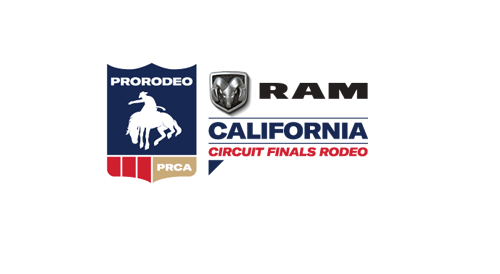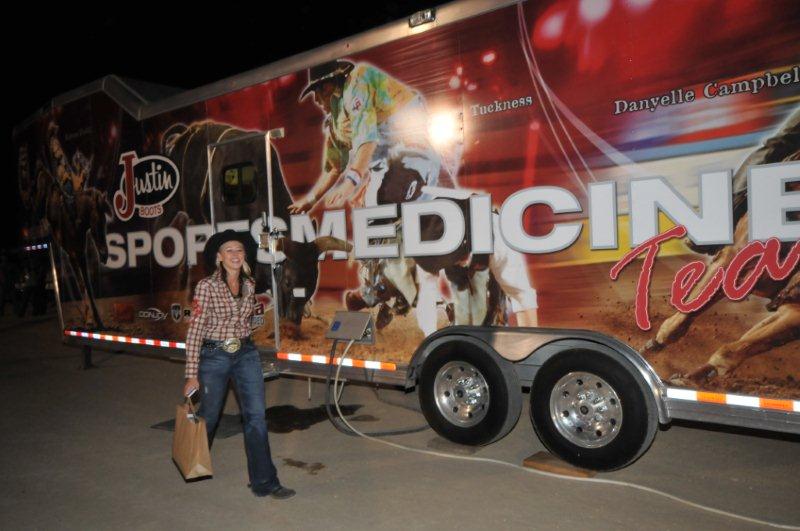So what does it mean to the riders when they see those black and red vests behind the chutes? "It means everything", said Price. For full story see below (Deseret News, Salt Lake City, Utah - July 2012)
We are proud to announce that the Justin Sportsmedicine Team (website Facebook ) will be on hand to provide comprehensive medical care to all of our athletes at the 2012 PRCA RAM California Circuit Finals Rodeo. We know are contestants are in good hands!
For more information about the Justin Cowboy Crisis Fund, visit website Facebook.
The following article appeared in the Salt Lake City, Utah, Deseret News on July 23, 2012 (written by Amy Donaldson - used with permission).
WEST VALLEY CITY — The kick from the horse was so jarring Taylor Price could barely find the strength to hobble out of Ogden's Pioneer Stadium.
Both of the bucking horses' back hooves connected with the 20-year-old Texas cowboy's right leg as he tried to get off the horse during the Ogden Rodeo's bareback competition Friday night.
"I couldn't really walk around, much less get on a bareback horse," said Price. "I couldn't put any pressure on my leg or turn my toes out."
The timing couldn't have been worse.
"I got kicked at a really bad time," he said. "I have some good rodeos coming up."
With rodeos nearly every night all across the West, cowboys can make up for a bad season if they can stay healthy.
But that's a pretty big if — especially when it comes to rough stock riders — bareback, saddle bronc and bull riders.
"It's not if an athlete will get hurt, but when," said Mike Stratton, an Arizona athletic trainer and physical therapist who is part of the Justin Sports Medicine traveling team. "Rodeo is a little bit different from other professional sports because all of the athletes will get hurt. And they are independent competitors so they don't have the luxury of a team doctor. If they don't ride, they don't get paid."
Which is why Price made his way to the Maverik Center in West Valley City. He was entered in the Days of '47 Rodeo, but he wasn't sure he would be able to ride because he could barely walk.
"I wasn't planning on riding when I went there," he said. "I wasn't in riding shape."
But Stratton was optimistic offering him a treatment that included heat, massage and Biofreeze.
"I was able to get on," he said. "I've felt great since then, and I'll be in Spanish Fork (Tuesday). It was really helpful to have those guys to fix me up."
Without the program, Price, who has health insurance through his parents, said he'd have to decide if he had the time and money to visit an emergency room because he's far from his Texas home.
"It means everything," he said. "They treat you right and it helps us a bunch."
Stratton said he sees a lot of cowboys like Price in his work with the Justin Sports Medicine Program, which began in 1981 when Dr. J. Pat Evans and Don Andrews decided a mobile medical treatment facility would enhance the professionalism of the sport by ensuring medical care for the athletes.
The Justin boot company began sponsoring it and spends about $1 million a year treating cowboys at the country's largest rodeos. In the three decades since the program began, the doctors and athletic trainers have administered more than $23 million in free health care. About 6,000 athletes are treated in a year.
In fact, the cowboys now trust the doctors with Justin Sports Medicine so much, they seek them out, even if they're competing in a nearby smaller rodeo.
"Our goal as the Justin Sports Medicine team is to treat the cowboy individually, but also to accumulate information about injury prevention. We use that to further educate and improve the sport of rodeo."
He said they see everything from a stubbed toe to migraines to broken necks and concussions. Doctors and athletic trainers who work with the rodeo athletes understand that they're likely going to ride unless it's a life-threatening situation.
Stratton said they had a cowboy with a broken clavicle on a recent night and they treated him as best they could, and then he switched hands, rode and earned some money.
"We see it all," he said. "We have open communication and we don't say if they can come back, we say when they come back. We send them to other rodeos for follow-up treatment and give them programs to work at home. Then we check up on them. Most of them follow up because they want to get healthy."
The Justin Sports Medicine program is unique because it uses a team of traveling doctors who rely on local doctors who live and work in the area hosting the rodeo.
"We have a sports medicine team that travels nationally but uses local support," Stratton said. "At Days of '47 it's Dr. R. Pepper Murray."
The program also has a cowboy crisis fund, which accepts donations and awards grants to cowboys who have sustained debilitating injuries competing in rodeo.
Stratton said that about 25 percent to 40 percent of those competing do not have health insurance.
"A lot of carriers won't carry a rough stock rider," he said. "Because the probability of injury is 100 percent."
So what does it mean to the riders when they see those black and red vests behind the chutes?
"It means everything," Price said. Link to story

